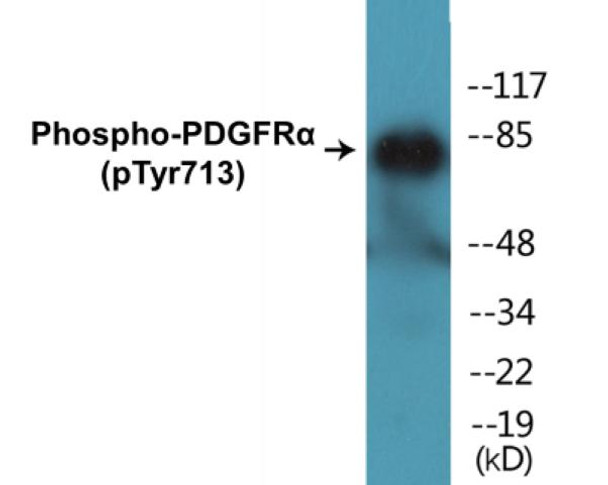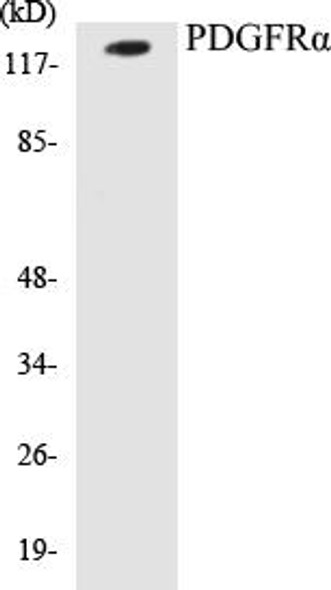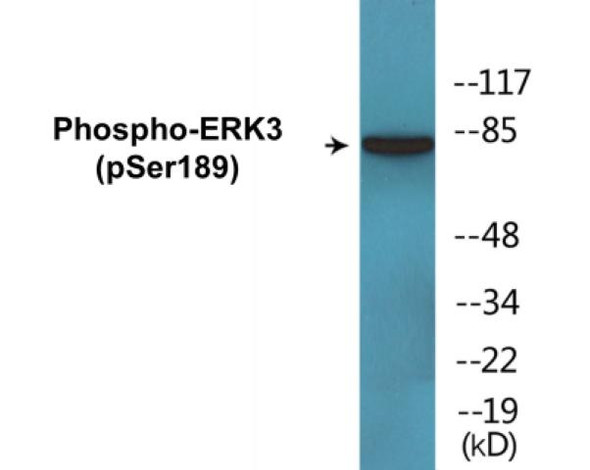Description
PDGFRalpha (Phospho-Tyr713)Colorimetric Cell-Based ELISA Kit
The PDGFRalpha (phospho-Tyr713) Colorimetric Cell-Based ELISA Kit is a cutting-edge tool for the precise measurement of PDGFRalpha phosphorylated at Tyrosine 713 levels in cell samples. This kit offers exceptional sensitivity and specificity, ensuring accurate and reproducible results for a variety of research applications.PDGFRalpha is a key receptor involved in cell growth and differentiation, with phosphorylation at Tyrosine 713 critical for its activation.
Dysregulation of PDGFRalpha signaling is implicated in various diseases, including cancer, fibrosis, and vascular disorders, making it a valuable target for therapeutic interventions.By utilizing the PDGFRalpha (phospho-Tyr713) Colorimetric Cell-Based ELISA Kit, researchers can gain valuable insights into the role of PDGFRalpha in cellular processes and disease pathogenesis, ultimately leading to the development of novel treatment strategies.
| Product Name: | PDGFRalpha (Phospho-Tyr713) Colorimetric Cell-Based ELISA |
| Product Code: | CBCAB00426 |
| ELISA Type: | Cell-Based |
| Target: | PDGFRalpha (Phospho-Tyr713) |
| Reactivity: | Human, Mouse |
| Dynamic Range: | > 5000 Cells |
| Detection Method: | Colorimetric 450 nm |
| Format: | 2 x 96-Well Microplates |
The PDGFRalpha (Phospho-Tyr713) Colorimetric Cell-Based ELISA Kit is a convenient, lysate-free, high throughput and sensitive assay kit that can detect PDGFRalpha protein phosphorylation and expression profile in cells. The kit can be used for measuring the relative amounts of phosphorylated PDGFRalpha in cultured cells as well as screening for the effects that various treatments, inhibitors (ie. siRNA or chemicals), or activators have on PDGFRalpha phosphorylation.
Qualitative determination of PDGFRalpha (Phospho-Tyr713) concentration is achieved by an indirect ELISA format. In essence, PDGFRalpha (Phospho-Tyr713) is captured by PDGFRalpha (Phospho-Tyr713)-specific primary antibodies while the HRP-conjugated secondary antibodies bind the Fc region of the primary antibody. Through this binding, the HRP enzyme conjugated to the secondary antibody can catalyze a colorimetric reaction upon substrate addition. Due to the qualitative nature of the Cell-Based ELISA, multiple normalization methods are needed:
| 1. | A monoclonal antibody specific for human GAPDH is included to serve as an internal positive control in normalizing the target absorbance values. |
| 2. | Following the colorimetric measurement of HRP activity via substrate addition, the Crystal Violet whole-cell staining method may be used to determine cell density. After staining, the results can be analysed by normalizing the absorbance values to cell amounts, by which the plating difference can be adjusted. |
| Database Information: | Gene ID: 5175, UniProt ID: P16234, OMIM: 173445, Unigene: Hs.514412/Hs.709189 |
| Gene Symbol: | PDGFRA |
| Sub Type: | Phospho |
| UniProt Protein Function: | PDGFRA: a receptor tyrosine kinase of the PDGFR family that binds members of the platelet-derived growth factor family. The identity of the growth factor bound determines whether the functional receptor is a homodimer or a heterodimer, composed of both PDGFR-alpha and -beta. Ligand binding induces receptor dimerization and autophosphorylation. Particularly important for kidney development since mice heterozygous for the receptor exhibit defective kidney phenotypes. Chromosomal rearrangments activate PDGFRalpha by fusion to BCR, causing atypical chronic myelogenous leukemia (CML), and to FIP1L1, causing idiopathic hypereosinophilic syndrome. Activating point mutations cause a minority of gastrointestinal stromal tumors (GIST). Promoter polymorphisms linked to neural tube defects including spina bifida, verified by mouse mutant model. Inhibitors: Gleevec, Sutent. OMIM: Two alternatively-spliced isoforms have been described. |
| UniProt Protein Details: | Protein type:Protein kinase, tyrosine (receptor); Oncoprotein; Kinase, protein; Membrane protein, integral; Protein kinase, TK; EC 2.7.10.1; TK group; PDGFR family Chromosomal Location of Human Ortholog: 4q12 Cellular Component: microvillus; membrane; integral to plasma membrane; cytoplasm; plasma membrane; nucleus; intrinsic to plasma membrane; external side of plasma membrane Molecular Function:vascular endothelial growth factor receptor activity; protein binding; protein homodimerization activity; platelet-derived growth factor binding; platelet-derived growth factor receptor binding; platelet-derived growth factor alpha-receptor activity; transmembrane receptor protein tyrosine kinase activity; ATP binding Biological Process: estrogen metabolic process; extracellular matrix organization and biogenesis; peptidyl-tyrosine phosphorylation; regulation of chemotaxis; wound healing; nerve growth factor receptor signaling pathway; viral reproduction; protein amino acid autophosphorylation; platelet-derived growth factor receptor signaling pathway; cardiac myofibril assembly; palate development; elevation of cytosolic calcium ion concentration; positive regulation of fibroblast proliferation; Leydig cell differentiation; embryonic digestive tract morphogenesis; luteinization; positive regulation of cell proliferation; male genitalia development; epidermal growth factor receptor signaling pathway; phosphoinositide-mediated signaling; fibroblast growth factor receptor signaling pathway; in utero embryonic development; adrenal gland development; positive regulation of phosphoinositide 3-kinase activity; embryonic cranial skeleton morphogenesis; odontogenesis of dentine-containing teeth; embryonic skeletal morphogenesis; positive regulation of phosphoinositide 3-kinase cascade; cell activation; innate immune response; hemopoietic progenitor cell differentiation; positive regulation of DNA replication; lung development; positive regulation of cell migration Disease: Gastrointestinal Stromal Tumor; Hypereosinophilic Syndrome, Idiopathic |
| NCBI Summary: | This gene encodes a cell surface tyrosine kinase receptor for members of the platelet-derived growth factor family. These growth factors are mitogens for cells of mesenchymal origin. The identity of the growth factor bound to a receptor monomer determines whether the functional receptor is a homodimer or a heterodimer, composed of both platelet-derived growth factor receptor alpha and beta polypeptides. Studies suggest that this gene plays a role in organ development, wound healing, and tumor progression. Mutations in this gene have been associated with idiopathic hypereosinophilic syndrome, somatic and familial gastrointestinal stromal tumors, and a variety of other cancers. [provided by RefSeq, Mar 2012] |
| UniProt Code: | P16234 |
| NCBI GenInfo Identifier: | 129892 |
| NCBI Gene ID: | 5156 |
| NCBI Accession: | P16234.1 |
| UniProt Secondary Accession: | P16234,Q6P4H5, Q96KZ7, Q9UD28, B2RE69, E9PBH0, |
| UniProt Related Accession: | P16234 |
| Molecular Weight: | 1089 |
| NCBI Full Name: | Platelet-derived growth factor receptor alpha |
| NCBI Synonym Full Names: | platelet-derived growth factor receptor, alpha polypeptide |
| NCBI Official Symbol: | PDGFRA |
| NCBI Official Synonym Symbols: | CD140A; PDGFR2; PDGFR-2; RHEPDGFRA |
| NCBI Protein Information: | platelet-derived growth factor receptor alpha; PDGF-R-alpha; CD140a antigen; PDGFRA/BCR fusion; CD140 antigen-like family member A; platelet-derived growth factor receptor 2; alpha-type platelet-derived growth factor receptor; rearranged-in-hypereosinophilia-platelet derived growth factor receptor alpha fusion protein |
| UniProt Protein Name: | Platelet-derived growth factor receptor alpha |
| UniProt Synonym Protein Names: | Alpha platelet-derived growth factor receptor; Alpha-type platelet-derived growth factor receptor; CD140 antigen-like family member A; CD140a antigen; Platelet-derived growth factor alpha receptor; Platelet-derived growth factor receptor 2; PDGFR-2; CD_antigen: CD140a |
| Protein Family: | Platelet-derived growth factor receptor |
| UniProt Gene Name: | PDGFRA |
| UniProt Entry Name: | PGFRA_HUMAN |
| Component | Quantity |
| 96-Well Cell Culture Clear-Bottom Microplate | 2 plates |
| 10X TBS | 24 mL |
| Quenching Buffer | 24 mL |
| Blocking Buffer | 50 mL |
| 15X Wash Buffer | 50 mL |
| Primary Antibody Diluent | 12 mL |
| 100x Anti-Phospho Target Antibody | 60 µL |
| 100x Anti-Target Antibody | 60 µL |
| Anti-GAPDH Antibody | 60 µL |
| HRP-Conjugated Anti-Rabbit IgG Antibody | 12 mL |
| HRP-Conjugated Anti-Mouse IgG Antibody | 12 mL |
| SDS Solution | 12 mL |
| Stop Solution | 24 mL |
| Ready-to-Use Substrate | 12 mL |
| Crystal Violet Solution | 12 mL |
| Adhesive Plate Seals | 2 seals |
The following materials and/or equipment are NOT provided in this kit but are necessary to successfully conduct the experiment:
- Microplate reader able to measure absorbance at 450 nm and/or 595 nm for Crystal Violet Cell Staining (Optional)
- Micropipettes with capability of measuring volumes ranging from 1 µL to 1 ml
- 37% formaldehyde (Sigma Cat# F-8775) or formaldehyde from other sources
- Squirt bottle, manifold dispenser, multichannel pipette reservoir or automated microplate washer
- Graph paper or computer software capable of generating or displaying logarithmic functions
- Absorbent papers or vacuum aspirator
- Test tubes or microfuge tubes capable of storing ≥1 ml
- Poly-L-Lysine (Sigma Cat# P4832 for suspension cells)
- Orbital shaker (optional)
- Deionized or sterile water
*Note: Protocols are specific to each batch/lot. For the correct instructions please follow the protocol included in your kit.
| Step | Procedure |
| 1. | Seed 200 µL of 20,000 adherent cells in culture medium in each well of a 96-well plate. The plates included in the kit are sterile and treated for cell culture. For suspension cells and loosely attached cells, coat the plates with 100 µL of 10 µg/ml Poly-L-Lysine (not included) to each well of a 96-well plate for 30 minutes at 37°C prior to adding cells. |
| 2. | Incubate the cells for overnight at 37°C, 5% CO2. |
| 3. | Treat the cells as desired. |
| 4. | Remove the cell culture medium and rinse with 200 µL of 1x TBS, twice. |
| 5. | Fix the cells by incubating with 100 µL of Fixing Solution for 20 minutes at room temperature. The 4% formaldehyde is used for adherent cells and 8% formaldehyde is used for suspension cells and loosely attached cells. |
| 6. | Remove the Fixing Solution and wash the plate 3 times with 200 µL 1x Wash Buffer for five minutes each time with gentle shaking on the orbital shaker. The plate can be stored at 4°C for a week. |
| 7. | Add 100 µL of Quenching Buffer and incubate for 20 minutes at room temperature. |
| 8. | Wash the plate 3 times with 1x Wash Buffer for 5 minutes each time. |
| 9. | Add 200 µL of Blocking Buffer and incubate for 1 hour at room temperature. |
| 10. | Wash 3 times with 200 µL of 1x Wash Buffer for 5 minutes each time. |
| 11. | Add 50 µL of 1x primary antibodies Anti-PDGFRalpha (Phospho-Tyr713) Antibody, Anti-PDGFRalpha Antibody and/or Anti-GAPDH Antibody) to the corresponding wells, cover with Parafilm and incubate for 16 hours (overnight) at 4°C. If the target expression is known to be high, incubate for 2 hours at room temperature. |
| 12. | Wash 3 times with 200 µL of 1x Wash Buffer for 5 minutes each time. |
| 13. | Add 50 µL of 1x secondary antibodies (HRP-Conjugated AntiRabbit IgG Antibody or HRP-Conjugated Anti-Mouse IgG Antibody) to corresponding wells and incubate for 1.5 hours at room temperature. |
| 14. | Wash 3 times with 200 µL of 1x Wash Buffer for 5 minutes each time. |
| 15. | Add 50 µL of Ready-to-Use Substrate to each well and incubate for 30 minutes at room temperature in the dark. |
| 16. | Add 50 µL of Stop Solution to each well and read OD at 450 nm immediately using the microplate reader. |
(Additional Crystal Violet staining may be performed if desired – details of this may be found in the kit technical manual.)






